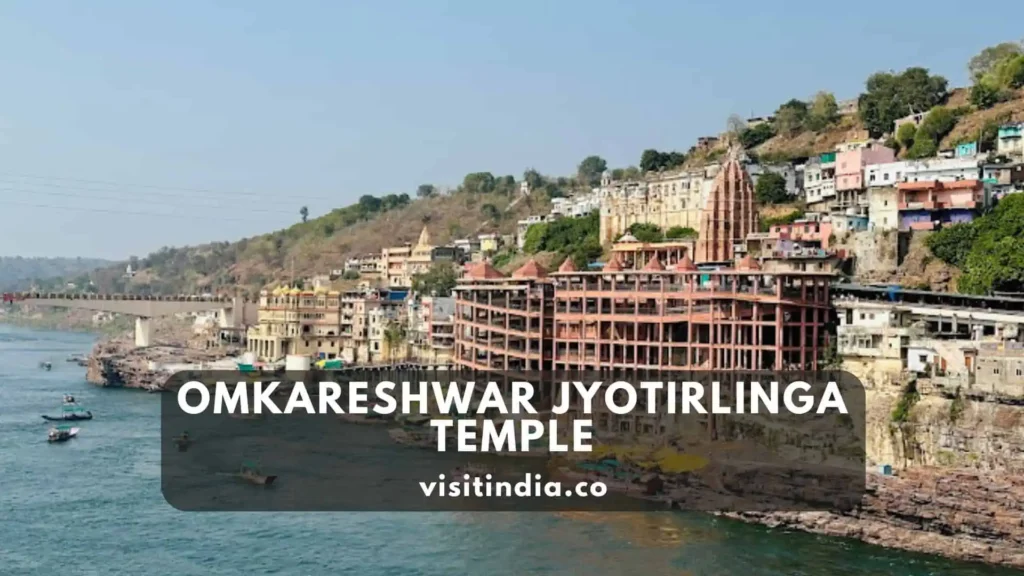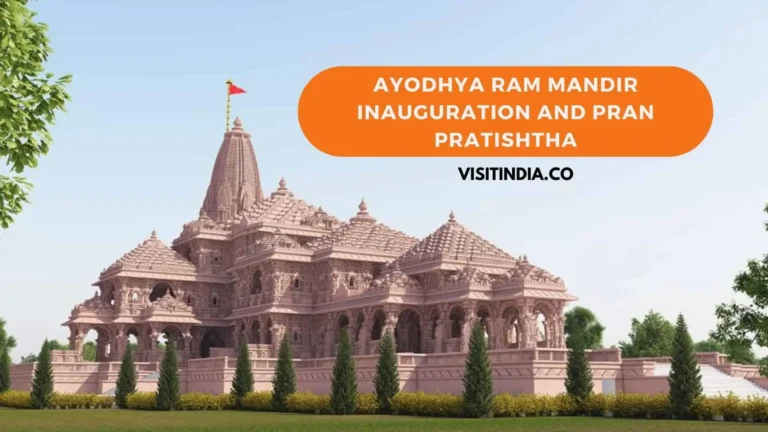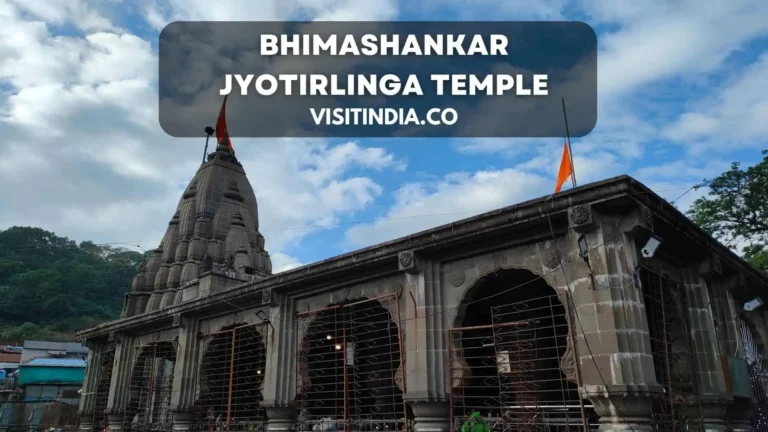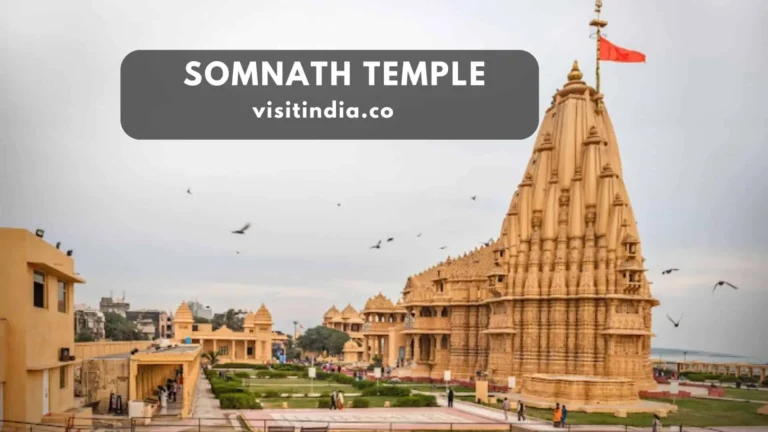Omkareshwar Jyotirlinga Temple Timings, Parikrama, Distance, Facts, Significance
Omkareshwar Jyotirlinga Temple is one of the most revered Hindu temples in India. Located on an island in the Narmada River, this ancient temple holds immense significance for devotees of Lord Shiva. In this article, we will explore the rich history, stunning architecture, and legends associated with this sacred place of worship.

The Omkareshwar Temple has a fascinating history that dates back centuries. It is believed to be one of the 12 Jyotirlinga temples in the world, with the fourth Jyotirlinga residing here. This alone makes it an important pilgrimage site for devotees. The temple’s location on an island in the Narmada River adds to its allure, as it symbolizes the union of the physical and spiritual worlds.
In this article, we will look at Omkareshwar Jyotirlinga Temple Timings, Parikrama, Distance, Facts, and Significance.
Consider reading: 12 Jyotirlingas in India Name, Location, Significance and Details
Omkareshwar Jyotirlinga Temple Darshan and Aarti Timings
Visiting the Omkareshwar Jyotirlinga Temple is a deeply spiritual experience for devotees. To make the most of your visit, it’s important to know the temple’s darshan and aarti timings. Here are the details:
- Morning Darshan: The temple opens bright and early at 5:00 AM and darshan continues until 3:50 PM.
- Evening Darshan: After a short break, the temple reopens at 4:15 PM and Darshan is available until 9:30 PM.
- Mangal Aarti: If you wish to witness the divine awakening, the Mangal Aarti takes place from 5:00 AM to 5:30 AM. This early morning ritual is a sacred experience not to be missed.
- Jalabhishek: Another important ritual at the temple is the Jalabhishek, which is performed from 5:30 AM to 12:25 PM. It involves the pouring of holy water on the lingam, symbolizing our devotion to Lord Shiva.
- Evening Aarti: The day ends with the enchanting Evening Aarti, held from 8:20 PM to 9:05 PM. This mesmerizing ritual fills the atmosphere with a sense of divinity.
Keep in mind that these timings are subject to change during special occasions and festivals. It is always recommended to check for any updates before planning your visit.
So, plan your visit accordingly and immerse yourself in the divine atmosphere of Omkareshwar Jyotirlinga Temple during these darshan and aarti timings.
Consider reading: Mallikarjuna Jyotirlinga Temple Srisailam Timings, How to Reach, History, Facts, Nearby Places to Visit
Omkareshwar Jyotirlinga Temple distance from Ujjain and Indore
When it comes to planning a visit to the Omkareshwar Jyotirlinga Temple, it’s important to consider the distance from major cities in Madhya Pradesh. Two key cities that are often included in the itinerary are Ujjain and Indore, both known for their religious significance and cultural heritage.
- From Ujjain: The distance between Ujjain and Omkareshwar is approximately 137 km. This drive takes about 3 hours, depending on the traffic and road conditions. Many devotees combine their visits to both the Mahakaleshwar Jyotirlinga in Ujjain and the Omkareshwar Jyotirlinga for a complete spiritual experience.
- From Indore: For those starting their journey from Indore, the distance to Omkareshwar is around 76 km. It takes approximately 2 hours to reach the temple complex by road. Indore, being one of the largest cities in Madhya Pradesh, offers good connectivity and transportation options to make the pilgrimage comfortable.
Both Ujjain and Indore act as popular entry points for pilgrims visiting Omkareshwar Jyotirlinga Temple. Devotees can choose to travel by private vehicles, public buses, or even hire taxis for a hassle-free journey. It is advisable to check the road conditions and plan the trip accordingly.
Remember to check for any updates related to travel restrictions or guidelines before your visit, as these may vary depending on the prevailing circumstances. The popularity of the Omkareshwar Jyotirlinga draws visitors from all over India, making it essential to plan your trip well in advance to avoid any inconvenience.
Consider reading: Parli Vaijnath Jyotirlinga Temple Timings, How to Reach, Rituals and Festivals
Places to Visit Near Omkareshwar Jyotirlinga Temple
When visiting Omkareshwar Jyotirlinga Temple, there are several other attractions nearby that are worth exploring. Here are some top places to visit near the temple:
- Mandavgad: Located near Omkareshwar, Mandavgad is a captivating city on a plateau. Recognized as a UNESCO World Heritage Site, it is home to magnificent palaces and monuments. Architecture enthusiasts and history buffs will be amazed by the intricate designs and rich cultural heritage of this city.
- Kajal Rajni Cave: Situated near the island of Omkareshwar, the Kajal Rajni Cave offers picturesque scenery and tranquility. It’s a popular tourist spot and an ideal place for a peaceful picnic with friends and family. Immerse yourself in the serene landscape and enjoy the beauty of nature.
As you plan your visit to Omkareshwar Jyotirlinga Temple, make sure to include these nearby attractions in your itinerary. The combination of spirituality, history, and natural beauty will make your trip even more memorable.
History Behind the Omkareshwar Jyotirlinga Temple
The Omkareshwar Jyotirlinga Temple, steeped in millennia of history, stands as a testament to ancient spirituality and architectural marvel. Dating back over 5500 years as per sacred texts housed within its walls, this temple is a cornerstone in the tapestry of Hindu lore and reverence.
Constructed in the 11th century by the Paramara Kings of Malwa, the Omkareshwar Temple is a storied monument, surviving through various dynasties, including the Chauhan rulers, and weathering invasions with astonishing resilience. Its endurance through tumultuous times is a story of miraculous preservation.
Remarkably, the temple’s pristine beauty and sacred ambiance have been maintained, despite minimal renovations during the Mughal era. This enduring charm continues to beckon devotees globally, transcending time and history.
Central to the temple’s lore is the legend of King Mandhata. A paragon of virtue, King Mandhata’s devout penance led to Lord Shiva’s appearance, granting his wish by establishing a divine lingam on the Narmada River’s island, hence the name Omkareshwar.
As one of the revered 12 Jyotirlingas in India – the sacred manifestations of Lord Shiva – Omkareshwar Temple holds a pivotal place in Hindu spirituality. These Jyotirlingas are not just shrines but are pivotal to Hinduism’s spiritual geography, drawing millions in their quest for divine grace.
The Omkareshwar Jyotirlinga Temple, with its profound historical roots and spiritual significance, is more than just a temple. It’s a journey into the heart of Hindu traditions, an architectural wonder, and a beacon for those seeking spiritual awakening. This temple is not merely a structure but a living chronicle of faith and resilience, inviting all to experience its sanctity.
Consider reading: Somnath Temple Timings, History, Nearest Railway Station and Airport
Unique Facts About the Omkareshwar Jyotirlinga Temple
As I delve deeper into exploring the Omkareshwar Jyotirlinga Temple, I can’t help but come across some fascinating and unique facts that make this divine destination truly special. Let’s uncover these intriguing details:
- Sacred Island of Om: The Omkareshwar Jyotirlinga Temple is located on an enchanting island known as Mandhata or Shivapuri, situated in the mystical Narmada River. What’s truly captivating is that the island itself is shaped like the sacred syllable “Om” (ॐ) from Hinduism, symbolizing Lord Shiva. This alone creates a profound spiritual atmosphere, making each visit truly unforgettable.
- Self-Manifested Linga: The Omkareshwar Temple is one of the twelve Jyotirlinga temples in India which are believed to be self-manifested lingas. This means that the divine linga of Lord Shiva appeared on its own, without human intervention. Such a miraculous phenomenon adds to the temple’s significance and draws devotees seeking a direct connection with the divine.
- Peshwa Architectural Style: The Omkareshwar Temple showcases the intricate craftsmanship and architectural brilliance of the Peshwa style. Adorned with exquisite carvings and beautiful spires, the temple is a true testament to the grandeur and artistic finesse of ancient India. Every nook and corner exudes a sense of divinity and aesthetic splendor.
- Dual Shrines: Another interesting fact about the Omkareshwar Temple is that it consists of two ancient shrines – Omkareshwar and Amareshwar or Mamleshwar. The Omkareshwar Temple, dedicated to Lord Shiva, holds great reverence and is considered to be the fourth among the twelve revered Jyotirlinga shrines. The presence of these dual shrines adds to the spiritual significance and magnificence of the temple complex.
The Omkareshwar Jyotirlinga Temple never ceases to amaze me with its rich history, architectural beauty, and divine aura. These unique facts only scratch the surface of what makes this temple an absolute marvel. Let’s continue our journey and uncover even more wonders that this sacred place has to offer.
Consider reading: Ayodhya Ram Mandir Inauguration, Pran Pratishtha Time, Rituals, Darshan and How to Watch
Significance of Omkareshwar Jyotirlinga Temple
The Omkareshwar Jyotirlinga Temple holds immense significance in Hindu mythology and is considered one of the twelve Jyotirlingas, which are believed to be the abodes of Lord Shiva. Here are some key reasons why the Omkareshwar Jyotirlinga is of great importance:
- Spiritual Significance: The temple is a place of profound spiritual significance and attracts devotees from all over the world. It is believed that by offering prayers and seeking blessings at the Omkareshwar Jyotirlinga, one can attain spiritual enlightenment and liberation from the cycle of life and death.
- Ancient Existence: The temple’s rich history dates back thousands of years, making it a revered landmark in Hindu culture. Its mention in ancient Hindu texts and its survival through various historical incidents, including Muslim invasions, highlight its enduring significance and resilience.
- Sacred Island: The Omkareshwar Temple is located on an island in the Narmada River, which is shaped like the auspicious syllable “Om.” This unique geographical feature adds to the temple’s sacredness and makes it a place of deep reverence for devotees.
- Architectural Marvel: The temple’s architecture is a blend of exquisite craftsmanship and ancient design principles. The Peshwa architectural style is evident in its intricate carvings, magnificent spires, and ornate pillars. This architectural marvel is a testament to the creativity and skill of the artisans of the time.
- Pilgrimage Destination: The Omkareshwar Jyotirlinga is a significant pilgrimage site for devotees of Lord Shiva. Many devotees undertake a journey to this sacred place to seek blessings, offer prayers, and participate in religious ceremonies. The temple provides a peaceful and serene atmosphere for spiritual seekers.
The Omkareshwar Jyotirlinga’s significance and grandeur go beyond words. Its rich history, spiritual significance, unique location, and architectural brilliance make it a must-visit destination for those seeking divine blessings and a deeper connection with Lord Shiva.
Consider reading: Ujjain Mahakal Mandir Darshan, Timing, Bhasma Aarti Online Booking Details
Omkareshwar Jyotirlinga Temple Parikrama
The Omkareshwar Parikrama, a revered component of the pilgrimage to the Omkareshwar Jyotirlinga Temple, embodies a profound spiritual journey. Circling Omkar Hill, this 8 km path represents more than a physical trek; it’s a voyage into the depths of spiritual awakening and harmony.
Embarking on this 3-hour journey immerses pilgrims in breathtaking landscapes. The verdant surroundings and the tranquil environment provide an idyllic backdrop for introspection and spiritual connection. It’s a walk through nature’s embrace, aiding pilgrims in gathering positive energy and attaining inner peace.
Along the Parikrama route, a series of captivating temples enrich the experience. Each temple serves as a serene haven, inviting devotees to pause, offer prayers, and delve deeper into their spiritual quests. These sacred spots along the Parikrama path accentuate the mystical charm of the journey.
More than a physical endeavor, the Omkareshwar Parikrama is a pathway to spiritual enlightenment. It offers an opportunity for self-reflection and divine communion, leading to an inner transformation. Completing this sacred circuit leaves one with a profound sense of spiritual fulfillment and a strengthened bond with the divine.
In essence, the Omkareshwar Parikrama is a vital facet of the pilgrimage to the Omkareshwar Jyotirlinga Temple. It’s an opportunity to extend one’s devotion beyond the temple walls, engaging in a ritual that is as spiritually enriching as it is serene.
Consider reading: Char Dham Yatra in India Name, Places, and Details
Final Thoughts on Omkareshwar Jyotirlinga Temple
Having explored the rich history, spiritual significance, and unique features of the Omkareshwar Jyotirlinga Temple, it is evident that this sacred place holds a special place in the hearts of devotees. The temple’s survival through the ages, its association with the Chauhan rulers, and its mention in ancient Hindu texts all contribute to its historical and cultural significance.
The architecture and design of the temple, with its intricate carvings, magnificent spires, and ornate pillars, showcase the exquisite craftsmanship and ancient design principles. The temple’s location on an island shaped like the auspicious syllable “Om” adds to its sacredness and makes it a place of deep reverence.
For devotees seeking spiritual enlightenment and liberation, the Omkareshwar Jyotirlinga is a place of profound significance. The temple offers a peaceful and serene atmosphere for spiritual seekers, where they can offer prayers, seek blessings, and participate in religious ceremonies.
The Omkareshwar Parikrama, a path that circumambulates Omkar Hill, is not just a physical journey but also a spiritual one. This spiritual journey allows devotees to connect with the divine and seek inner transformation. The picturesque scenery and the opportunity to visit other temples along the way make the parikrama an enriching experience.
FAQs on Omkareshwar Jyotirlinga Temple
What is the story behind Omkareshwar Jyotirlinga Temple?
The third story from Hindu scriptures reveals that there was a great war between the Devas (gods) and Danavas (demons), in which the Danavas won. This was a major setback for Devas and hence Devas prayed to Shiva. Pleased with their prayer, Shiva emerged in the form of Omkareshwar Jyotirlinga and defeated Danavas.
What is the difference between Omkareshwar and Mahakaleshwar?
Mahakaleshwar and Omkareshwar Jyotirlingas are major pilgrimage sites associated with Lord Shiva in Madhya Pradesh. While Mahakaleshwar Jyotirlinga is situated in the ancient city of Ujjain, Omkareshwar Jyotirlinga is located in Khandwa.
How many Jyotirlinga are there in Omkareshwar Jyotirlinga Temple?
There are two jyotirlinga temples – Omkareshwar and Mamaleshwar together it makes One of the 12 jyotirlingas. One can hire a boat or walk across the bridge to reach these temples. Walking will not be difficult. Temple staff and the pundits/brokers here are hand-in-glove and try to fleece the devotees.
Which major city is near Omkareshwar Jyotirlinga Temple?
Omkareshwar is located approximately 77 kilometers from Indore, the nearest major city. The easiest way to get to Omkareshwar is by road, with buses and taxis available from Indore.
What is special in Omkareshwar Jyotirlinga Temple?
It is one of the 12 Jyotirlingas visited every year by a large number of pilgrims. The Island of Omkareshwar is naturally shaped like OM, the sacred Hindu symbol. The 270 ft. The three-storey Gauri Somnath Temple is made in the shape of a Peahen.





